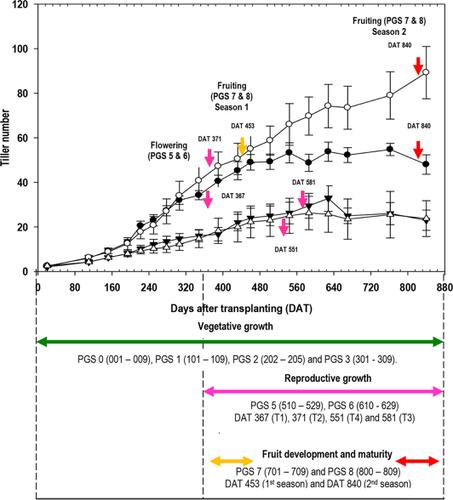当前位置:
X-MOL 学术
›
Ann. Appl. Biol.
›
论文详情
Our official English website, www.x-mol.net, welcomes your feedback! (Note: you will need to create a separate account there.)
Thaumatococcus daniellii phenology and growing degree day requirements under different irradiance and fertiliser levels
Annals of Applied Biology ( IF 2.6 ) Pub Date : 2020-01-14 , DOI: 10.1111/aab.12564 Nurul H. Mohd Khairlani 1 , Mohd Y. Abdullah 1 , Shamsiah Abdullah 1
Annals of Applied Biology ( IF 2.6 ) Pub Date : 2020-01-14 , DOI: 10.1111/aab.12564 Nurul H. Mohd Khairlani 1 , Mohd Y. Abdullah 1 , Shamsiah Abdullah 1
Affiliation

|
Thaumatococcus daniellii is a rhizomatous monocotyledonous, perennial herb species of the Marantaceae family. The fruit aril contains thaumatin, a sweet protein with sweetness intensity that is about 1,600–3,000 times that of sucrose and is extensively employed as a natural sweetener. The species has potential as an imperative economic crop if cultivated under proper agronomic practices. Phenological development and thermal time requirements are critical to ensuring a high yield. The aim of this study was to determine the phenological stages according to the BBCH scale and growing degree days (GDDs) under different irradiance and fertiliser levels. Seedlings were raised from rhizomes and grown on the field using a randomised complete block design with four treatments and three replications. The study was carried out at the Botanical Garden, Shah Alam, Malaysia, from July 2014 to February 2017. The treatments consisted of combinations of two irradiance and two fertiliser levels, which were designated as high irradiance with either low (T1) or high fertiliser (T2) and low irradiance with either low (T3) or high fertiliser (T4). A detailed phenological development using two‐ and three‐digit coding systems was conducted on 12 clumps (one clump/replicate/treatment). The species has eight principal stages, which include bud and leaf development, formation of side tillering, petiole elongation, emergence of synflorescence, flowering, fruit development and fruit maturity. Both irradiance and fertiliser levels affected certain phenological stages; with leaf, tiller, synflorescence and fruit strongly influenced by irradiance levels. Leaf growth was more vigorous under high irradiances compared with low irradiances and took about 36 to 42 days to attain full maturity. The clump growth or size is a function of tiller numbers. The tiller number increased with increase in clump age. The onset of certain phenological stages was associated with clump age. The clumps commenced production of synflorescence when tiller number was in the range of 30 to 40, and started fruit formation when tiller number reached 70. Both events occurred under a combination treatment of high irradiance with high fertiliser. The GDD requirement of any phenological stage or development of any plant part is contingent upon the duration of a particular stage or process, as measured in days after emergence or transplanting. The longer the duration, the higher the GDD and it varies with treatments. The total GDD required for the completion of the single leaf growth ranged from 852 to 1,022°C, while the emergence of synflorescence under high irradiance occurred with GDD of 5621 (T2) and low irradiance at 9387°C (T3). Fruit formation was observed only under high irradiance with GDD ranging from 9030 (T2) to 13,147°C (T1) during the study period. A description of phenological development according to BBCH scale and GDD requirements in response to differences in irradiance and fertiliser is imperative. It provides a detailed knowledge based on T. daniellii development vis‐à‐vis growth and environmental requirements. This will pave the way for attainment of an efficient crop agronomic practice.
中文翻译:

不同辐照度和施肥水平下达氏梭菌的物候和生长日需求
达尼氏梭菌是the兰科的多年生单子叶多年生草本植物。水果假种皮含有甜蛋白,一种甜度高的甜蛋白,约为蔗糖的1,600–3,000倍,被广泛用作天然甜味剂。如果在适当的农艺方法下耕种,该物种有潜力成为当务之急的经济作物。物候发展和热时间要求对于确保高产量至关重要。这项研究的目的是根据BBCH量表和不同辐照度和肥料水平下的生长度日(GDDs)确定物候期。从根茎上长出幼苗,并使用四次处理和三次重复的随机完整块设计在田间生长。这项研究是在马来西亚莎阿南植物园进行的,从2014年7月至2017年2月。治疗包括两种辐照度和两种肥料水平的组合,分别指定为低辐照度(T1)或高肥料(T2)的高辐照度和低辐照度(T3)或高肥料的低辐照度(T4)。使用两位数和三位数编码系统对12个丛进行了详细的物候发展(一个丛/重复/处理)。该物种有八个主要阶段,包括芽和叶发育,侧till形成,叶柄伸长,花序出现,开花,果实发育和果实成熟。辐照度和肥料水平都会影响某些物候期。叶,分till,花序和果实受辐照水平强烈影响。与低辐照相比,高辐照下叶片的生长更加旺盛,大约需要36至42天才能完全成熟。团块的生长或大小是分till数的函数。分cl数随丛生年龄的增加而增加。某些物候阶段的发作与团块年龄有关。当分till数在30到40之间时,团块开始产生花序,当分till数达到70时开始结实。这两个事件都是在高辐照度与高肥料组合处理下发生的。任何物候期或植物任何部分发育的GDD要求取决于特定阶段或过程的持续时间,具体取决于出苗或移植后的天数。持续时间越长,GDD越高,并且随治疗而变化。完成单叶生长所需的总GDD在852至1,022°C的范围内,而在高辐照度下出现了花序开花,其GDD为5621(T2),在低辐照度下为9387°C(T3)。在研究期间,只有在GDD为9030(T2)至13,147°C(T1)的高辐照度下才能观察到果实形成。必须根据BBCH规模和GDD要求对辐照度和肥料差异做出物候发展的描述。它提供了基于以下方面的详细知识 研究期间为147°C(T1)。必须根据BBCH量表和GDD要求对物候发展进行描述,以应对辐照度和肥料的差异。它提供了基于以下方面的详细知识 研究期间为147°C(T1)。必须根据BBCH量表和GDD要求对物候发展进行描述,以应对辐照度和肥料的差异。它提供了基于以下内容的详细知识Ť。相对于增长和环境要求的达涅利发展。这将为获得有效的农艺实践铺平道路。
更新日期:2020-01-14
中文翻译:

不同辐照度和施肥水平下达氏梭菌的物候和生长日需求
达尼氏梭菌是the兰科的多年生单子叶多年生草本植物。水果假种皮含有甜蛋白,一种甜度高的甜蛋白,约为蔗糖的1,600–3,000倍,被广泛用作天然甜味剂。如果在适当的农艺方法下耕种,该物种有潜力成为当务之急的经济作物。物候发展和热时间要求对于确保高产量至关重要。这项研究的目的是根据BBCH量表和不同辐照度和肥料水平下的生长度日(GDDs)确定物候期。从根茎上长出幼苗,并使用四次处理和三次重复的随机完整块设计在田间生长。这项研究是在马来西亚莎阿南植物园进行的,从2014年7月至2017年2月。治疗包括两种辐照度和两种肥料水平的组合,分别指定为低辐照度(T1)或高肥料(T2)的高辐照度和低辐照度(T3)或高肥料的低辐照度(T4)。使用两位数和三位数编码系统对12个丛进行了详细的物候发展(一个丛/重复/处理)。该物种有八个主要阶段,包括芽和叶发育,侧till形成,叶柄伸长,花序出现,开花,果实发育和果实成熟。辐照度和肥料水平都会影响某些物候期。叶,分till,花序和果实受辐照水平强烈影响。与低辐照相比,高辐照下叶片的生长更加旺盛,大约需要36至42天才能完全成熟。团块的生长或大小是分till数的函数。分cl数随丛生年龄的增加而增加。某些物候阶段的发作与团块年龄有关。当分till数在30到40之间时,团块开始产生花序,当分till数达到70时开始结实。这两个事件都是在高辐照度与高肥料组合处理下发生的。任何物候期或植物任何部分发育的GDD要求取决于特定阶段或过程的持续时间,具体取决于出苗或移植后的天数。持续时间越长,GDD越高,并且随治疗而变化。完成单叶生长所需的总GDD在852至1,022°C的范围内,而在高辐照度下出现了花序开花,其GDD为5621(T2),在低辐照度下为9387°C(T3)。在研究期间,只有在GDD为9030(T2)至13,147°C(T1)的高辐照度下才能观察到果实形成。必须根据BBCH规模和GDD要求对辐照度和肥料差异做出物候发展的描述。它提供了基于以下方面的详细知识 研究期间为147°C(T1)。必须根据BBCH量表和GDD要求对物候发展进行描述,以应对辐照度和肥料的差异。它提供了基于以下方面的详细知识 研究期间为147°C(T1)。必须根据BBCH量表和GDD要求对物候发展进行描述,以应对辐照度和肥料的差异。它提供了基于以下内容的详细知识Ť。相对于增长和环境要求的达涅利发展。这将为获得有效的农艺实践铺平道路。



























 京公网安备 11010802027423号
京公网安备 11010802027423号